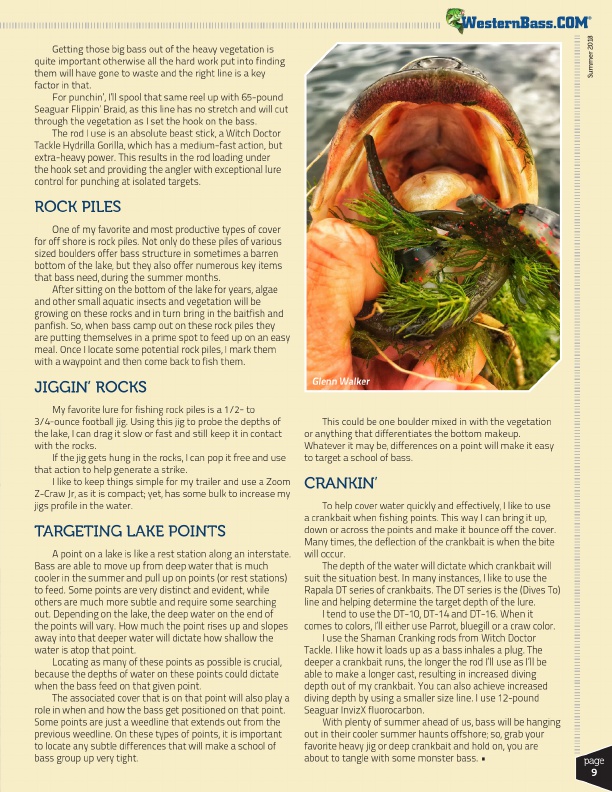
®
Getting those big bass out of the heavy vegetation is quite important otherwise all the hard work put into finding them will have gone to waste and the right line is a key factor in that.
For punchin’, I’ll spool that same reel up with 65-pound Seaguar Flippin’ Braid, as this line has no stretch and will cut through the vegetation as I set the hook on the bass.
The rod I use is an absolute beast stick, a Witch Doctor Tackle Hydrilla Gorilla, which has a medium-fast action, but extra-heavy power. This results in the rod loading under the hook set and providing the angler with exceptional lure control for punching at isolated targets.
ROCK PILES
One of my favorite and most productive types of cover for off shore is rock piles. Not only do these piles of various sized boulders offer bass structure in sometimes a barren bottom of the lake, but they also offer numerous key items that bass need, during the summer months.
After sitting on the bottom of the lake for years, algae and other small aquatic insects and vegetation will be growing on these rocks and in turn bring in the baitfish and panfish. So, when bass camp out on these rock piles they are putting themselves in a prime spot to feed up on an easy meal. Once I locate some potential rock piles, I mark them with a waypoint and then come back to fish them.
JIGGIN’ ROCKS
My favorite lure for fishing rock piles is a 1/2- to 3/4-ounce football jig. Using this jig to probe the depths of the lake, I can drag it slow or fast and still keep it in contact with the rocks.
If the jig gets hung in the rocks, I can pop it free and use that action to help generate a strike.
I like to keep things simple for my trailer and use a Zoom Z-Craw Jr, as it is compact; yet, has some bulk to increase my jigs profile in the water.
TARGETING LAKE POINTS
A point on a lake is like a rest station along an interstate. Bass are able to move up from deep water that is much cooler in the summer and pull up on points (or rest stations) to feed. Some points are very distinct and evident, while others are much more subtle and require some searching out. Depending on the lake, the deep water on the end of the points will vary. How much the point rises up and slopes away into that deeper water will dictate how shallow the water is atop that point.
Locating as many of these points as possible is crucial, because the depths of water on these points could dictate when the bass feed on that given point.
The associated cover that is on that point will also play a role in when and how the bass get positioned on that point. Some points are just a weedline that extends out from the previous weedline. On these types of points, it is important to locate any subtle differences that will make a school of bass group up very tight.
Glenn Walker
This could be one boulder mixed in with the vegetation or anything that differentiates the bottom makeup. Whatever it may be, differences on a point will make it easy to target a school of bass.
CRANKIN’
To help cover water quickly and effectively, I like to use a crankbait when fishing points. This way I can bring it up, down or across the points and make it bounce off the cover. Many times, the deflection of the crankbait is when the bite will occur.
The depth of the water will dictate which crankbait will suit the situation best. In many instances, I like to use the Rapala DT series of crankbaits. The DT series is the (Dives To) line and helping determine the target depth of the lure.
I tend to use the DT-10, DT-14 and DT-16. When it comes to colors, I’ll either use Parrot, bluegill or a craw color.
I use the Shaman Cranking rods from Witch Doctor Tackle. I like how it loads up as a bass inhales a plug. The deeper a crankbait runs, the longer the rod I’ll use as I’ll be able to make a longer cast, resulting in increased diving depth out of my crankbait. You can also achieve increased diving depth by using a smaller size line. I use 12-pound Seaguar InvizX fluorocarbon.
With plenty of summer ahead of us, bass will be hanging out in their cooler summer haunts offshore; so, grab your favorite heavy jig or deep crankbait and hold on, you are about to tangle with some monster bass. •
Summer 2018
page
9